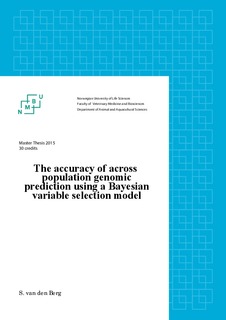| dc.contributor.author | van den Berg, Sanne | |
| dc.date.accessioned | 2015-11-05T15:03:10Z | |
| dc.date.available | 2015-11-05T15:03:10Z | |
| dc.date.copyright | 2015 | |
| dc.date.issued | 2015-11-05 | |
| dc.identifier.uri | http://hdl.handle.net/11250/2359501 | |
| dc.description.abstract | Background: The use of information across populations is an attractive approach to increase the accuracy of genomic prediction for numerically small populations. However, accuracies of across population genomic prediction, in which reference and selection individuals are from different populations, are currently disappointing. The objective of this study is to estimate the accuracy of across population genomic prediction using a Bayesian variable selection model and compare the obtained accuracies with the accuracy obtained by a GBLUP model. In this study, high density genotypes of 1033 HF, 147 MRY and 105 GWH are used. The phenotypes are simulated for two changing variables: (1) the number of QTL underlying the trait (3000, 300, 30, 3) and (2) the genetic correlation across populations (0.4, 0.8, 1.0). Results: The accuracy of across population genomic prediction obtained by a Bayesian variable selection model was the highest for a small number of QTL underlying the simulated trait. When the number of QTL increased, the accuracy of genomic prediction declined and eventually reached a plateau. This trend is stronger for across population genomic prediction than for within genomic prediction. Comparing the accuracy of across population genomic prediction obtained by Bayesian variable selection and GBLUP, it is shown that Bayesian variable selection has an advantage over GBLUP when the number of QTL underlying the simulated trait is small. However this advantage diminishes when the number of QTL underlying the simulated trait increases. The point where the accuracy of the Bayesian variable selection model and GBLUP becomes equal can be approximated by the independent number of chromosome fragments (Me). Conclusion: Bayesian variable selection performs better than GBLUP when the number of QTL underlying the trait is smaller than Me. Across populations Me is approximately ten times larger than within populations. So if the actual number of QTL is smaller than Me, the use of Bayesian variable selection models can help to improve the accuracy of across population genomic prediction. | nb_NO |
| dc.language.iso | eng | nb_NO |
| dc.publisher | Norwegian University of Life Sciences, Ås | |
| dc.title | The accuracy of across population genomic predictionusing a Bayesian variable selection model | nb_NO |
| dc.title.alternative | Nøyaktigheten av over-populasjon genomisk prediksjon ved hjelp av et Bayesiansk variabel seleksjon modell | nb_NO |
| dc.type | Master thesis | nb_NO |
| dc.subject.nsi | VDP::Agriculture and fishery disciplines: 900::Agriculture disciplines: 910::Livestock breeding, rearing, reproduction: 912 | nb_NO |
| dc.subject.nsi | VDP::Mathematics and natural science: 400::Basic biosciences: 470::Genetics and genomics: 474 | nb_NO |
| dc.source.pagenumber | 24 | nb_NO |
| dc.description.localcode | M-ABG | nb_NO |
